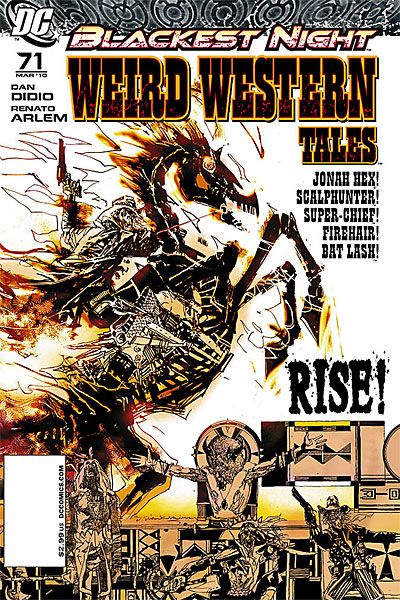Though Renato Arlem's interior art doesn't even come close to matching the bold ferocity of the Bill Sienkiewicz cover of this "Blackest Night" resurrection of "Weird Western Tales," it's some of the better Arlem work I've seen. His work tends to suffer from too many Photoshop filters, too many images cut and cropped and re-arranged in different panels, and it didn't particularly work effectively in his "Freedom Fighters" issues or his work on Marvel's "Annihilation" spin-offs.
Here, with the Western setting and the gritty landscape, it looks pretty good.
The story isn't bad, either, for what it is. It knows it's a "Blackest Night" tie-in comic; That's the whole reason for its existence, and it takes the form we've come to know and love (or, more likely, know and be sick of already), which is basically this: dead characters from the protagonist's past come back as Black Lanterns. Some kind of race-and-chase conflict ensues. The protagonist has both interior and exterior conflict because, hey, this zombie is my loved one, but, double hey, it's a zombie!
We know this formula from every "Blackest Night"-related issue, and so the fun comes when the writers veer from the formula a bit. Here, Dan DiDio provides a few fake-outs that make the staid formula a bit more fun. Trashy fun. But that's what you look for in a comic called "Weird Western Tales," anyway.
First, he makes us think that this is a traditional Western setting -- the old West -- when the second page undermines that assumption with the introduction of a cell phone. The protagonist is the descendent of Quentin Turnbull, one of Jonah Hex's famous bad guys, and we quickly move from a classic movie ghost town to an underground high-tech bunker, where Simon Stagg and friends assemble. Even the Ray joins the party, bringing a superhero connection to this weird western tale. (In addition to, you know, the magical Black Lantern rings and the as-promised-on-the-cover return of Super-Chief.)
Characters die unexpectedly, and zombie Jonah Hex appears. So does Quentin Turnbull, but the denouement doesn't go the way I anticipated. It doesn't follow the formula. And that violent reversal in the final pages helps add to the dark humor of the entire issue.
If you're reading "Blackest Night" and you want a tie-in to bide you over, you could do a lot worse than this one. Unless, of course, you take "Blackest Night" seriously. But why would you want to do that?

